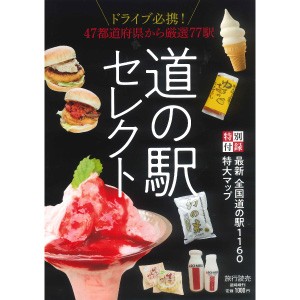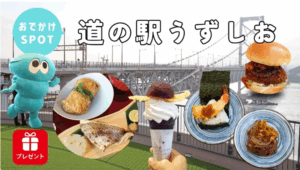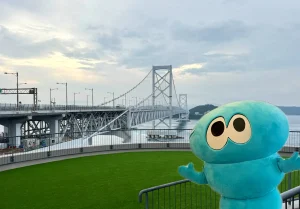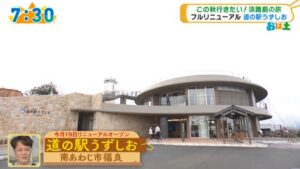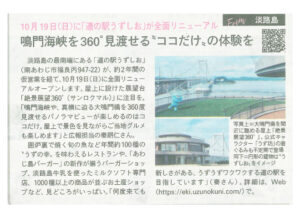
The 1629-meter Onaruto Bridge spans the Naruto Straits, famous for its whirlpools, at the southwestern tip of Awaji Island. At the foot of the bridge is "Roadside Station Uzushio.
In ancient times, Awaji Island was known as the "Goshoku Kuni" (Land of Food), where food was offered to the emperor. Even today, the island is known as a treasure trove of food ingredients, including seafood from the Seto Inland Sea, Awaji beef, and onions. Michi no Eki Uzushio is a delicious roadside station where such Awaji Island foods are gathered.
The burger store Awajishima Burger Awajishima Onion Kitchen Main Branch has burgers that won first (2013) and second (2014) place in the National Local Burger Grand Prix.
I immediately started eating the Awajishima Onion Beef Burger, which won first place. I thought the main ingredient was Awaji beef, but to my surprise, it was a cutlet of Awaji Island onions. The thick onion cutlets were cooked and sweet as they emerged from the crispy fried crust! I was surprised at the taste and presence that was as good as the rich umami of the Awaji beef and the homemade tomato sauce.
The burger was conceived to be entered in the Grand Prix, and after winning third place in 2011, the burger was refined and improved upon, winning second place in 2012 and the coveted first place in 2013. Many people flock to the small roadside station on the southwestern tip of Awaji Island to enjoy such an exquisite burger, and the number of customers doubles every year. On weekends and during the summer vacation, the line for the burger can be as long as 20 to 30 people.
The restaurant now offers about 10 different kinds of burgers. Many of them are seasonal and limited in quantity, such as the Awaji Island hamo cutlet burger (880 yen), sold in limited quantities in summer (20 burgers per day), but these are sometimes sold out in the morning.

White Kaisendon, a bowl of rice topped with fresh seafood, was created with ingredients from Awaji Island.
Winning the Grand Prix brought a turning point for the roadside station.
"When I saw people going out of their way to eat this burger, I realized that I could invite customers who want to eat the real thing, even if the price is a little high, with 'food. Awaji Island is also famous for its seafood, so seafood rice bowls are an essential menu item at restaurants, but it is different to put macro fish that cannot be caught in nearby waters on the menu. ...... Awaji Island is famous for its delicious white fish, such as hamo (eel) and shirasu (baby sardines) in summer and sea bream and Spanish mackerel in autumn, so we created the "White Kaisen-don" (white seafood bowl - what's today's catch? ~was born," says Yuuji Miyaji, station manager. The price is expensive for a roadside station (2,420 yen) because of the freshness and quality of the ingredients, but it has become very popular.
The sashimi and white rice are served separately. The sashimi is first dipped in soy sauce and served on top of the rice. Next, aromatic sesame seeds that you grind yourself are added to the special sesame sauce, which is then poured over the white rice topped with the white fish and served as a bowl of seafood. Chef Mitsunori Furuta, a native of Awaji Island and winner of the top prize in the Awaji Island Creative Cuisine Contest (2002), uses his ingenuity to further enhance the flavor of the seasonal white fish. Moreover, the restaurant has a spectacular view of the Onaruto Bridge beyond its windows. It is no wonder that the restaurant always ranks high in Internet rankings.
The store is crammed with about 800 Awaji Island souvenirs, including onions from local contract farmers and processed products from fishery companies. Of these, about 100 are original products.
We recommend the Awaji Island Onion Marugoto Curry (648 yen), which contains a whole onion grown on Awaji Island, and about 10 other retort curries using Awaji ingredients such as onions, Awaji beef, and baby sardines. Another attraction is that visitors can enjoy tasting more than 30 different kinds of onion dressing and onion soup.
The menus and panels are accompanied by detailed explanations of the island's food culture and its connection to the island. Shopping while wearing an onion-hair wig was a fun way to win prizes, and I was completely drawn in by the food charms of Awaji Island.
Dear Editorial Staff
Thank you very much for introducing us in your wonderful magazine!

